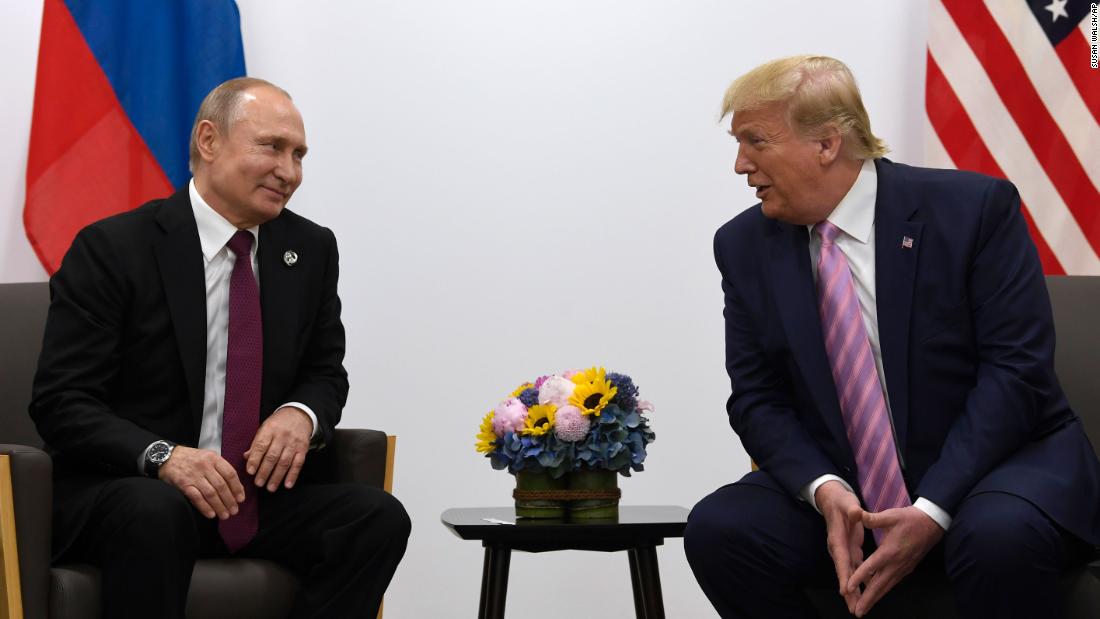Trump’s approach toward Ukraine, on the other hand, has been both confusing and worrisome. Russia forcefully annexed Crimea in 2014, and the two countries are still at war in eastern Ukraine. While the Trump administration provided lethal anti-tank weapons to Ukraine in 2017, Trump is
now mulling over a plan to block $250 million in military assistance to Ukraine, raising questions about how serious he is about helping Ukraine protect what’s left of its territorial integrity.
Any degradation of US support for Ukraine will be well received by Putin because he’ll feel like he’s getting a hall pass to keep breaking international law and violating other countries’ sovereignty.
While tensions between Ukraine and Russia remain extremely high, the two countries agreed to a prisoner swap Saturday, which Ukrainian President Volodymyr Zelensky hailed as “the first step to end the war.” Russia
returned prisoners, including Ukrainian sailors it captured in the Kerch Strait last year, among others. And Ukraine sent back to Moscow a
man suspected of taking part in the downing a Malaysian Airlines flight over eastern Ukraine in 2014.
Many leaders lauded the exchange as a positive step. They included Chancellor Angela Merkel of Germany, who said it
is worth continuing the hard work to implement the 2015 Ukraine-Russia ceasefire agreement, known as the Minsk Agreement. The ceasefire agreement
outlines several measures the parties agreed to take, including
the release and exchange of all hostages and unlawfully detained persons. Trump
added on Twitter that the swap may be a giant step toward peace.
While the prisoner swap can defuse some tensions, it does not change the reality that Russia illegally invaded and annexed Crimea. And Russia is still backing separatists in eastern Ukraine, while still unjustly holding many other Ukrainians in custody. The
US Embassy in Kiev and the
State Department pointed out these realities in their own statements, while welcoming the prisoner exchange.
Trump’s tweet indicating the swap is a giant step toward peace may raise alarm bells for any Americans, and allies, who understand Trump’s track record of declaring false victories and giving Putin presents.
It’s no secret that Trump’s eager to find reasons to praise Putin and claim that relations between the United States and Russia have improved (despite the fact that Russia is
still attacking our elections). While the prisoner swap may be a step toward eventually making peace, it isn’t a slam dunk, nor is it a substitute for Putin ordering Russian troops to leave Ukraine.
He could appeal to Trump’s constant focus on increasing trade and tell Trump that easing sanctions would help improve trade relations between the United States and Russia. The two leaders
have discussed trade issues during previous phone calls, and Trump has said that it’s ridiculous that we do so little trade with Russia — adding that
he sees “positive things happening.”
But until Putin fully implements the 2015 ceasefire agreements between Ukraine and Russia, his behavior doesn’t warrant the lifting of sanctions or an invitation to rejoin the G7. No matter how much Trump may want to make Putin happy, rewarding bad behavior will just greenlight more of it.
Freezing funds
Since Russia’s illegal activities began in 2014, Ukraine has counted on bipartisan US support. And thus far, Ukraine has received that; the United States has
provided Ukraine with $1 billion in security assistance since 2014. But, while the State Department
underscores our commitment to Ukraine’s territorial integrity and Vice President Mike Pence
says our relationship with Ukraine has never been stronger, the President may be leaving them out to dry — much to Russia’s delight.
Trump’s 2017 decision
to provide aid to Ukraine was likely ill-received in Moscow. But he has recently indicated he is considering putting a hold on $250 million in military assistance to Ukraine, citing an internal review. This freeze would be welcomed by Moscow because it would signal the administration is backing away from helping Ukraine deter and defend against Russian aggression.
The administration said the hold is a result of its review of foreign policy priorities after it lost its fight to
cut foreign aid spending by $4 billion. Trump is looking to make cuts elsewhere in the budget, but supporting Ukraine’s territorial integrity in the face of Russian aggression was likely never imagined to be on the chopping block.
Help wanted
The Ukrainians, however, are also well aware that Giuliani is trying to get dirt on former Vice President Joe Biden, a 2020 Democratic presidential candidate. Giuliani
called off his initially planned trip in May, blaming Democrats for trying to spin his travel as election interference. Months later, according to The New York Times, Giuliani is
continuing his efforts to investigate whether “sympathetic Ukrainians” conspired with Democrats to help launch what became special counsel Robert Mueller’s probe and to
dredge up a case that there were any improper ties between Biden’s diplomatic efforts in Ukraine and his
son’s work with a gas company there, among other matters. A Biden campaign official
called Giuliani’s efforts a political smear, and a campaign spokesperson
said Biden acted in Ukraine “without any regard for how it would or would not impact” his son’s business interests.
Plus, Giuliani’s engagement with the Ukrainian government blurs the line between official US business and Trump’s personal interests. While Giuliani said he
was acting on his own as a private citizen, the State Department
confirmed it put Giuliani in direct contact with a Ukrainian lawyer who Giuliani said is representing Zelensky.
Giuliani’s actions indicate that he wants help — from a foreign government. His efforts, coupled with the administration’s new freeze on assistance, could be interpreted as Trump holding Ukraine’s security hostage. Framed another way, it appears Trump may be putting his personal needs above US foreign policy priorities yet again.


